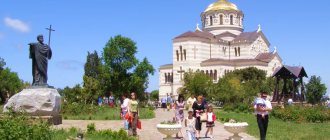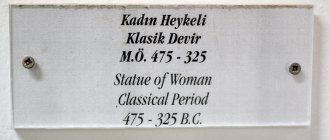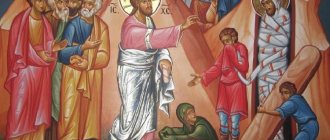Lazarus revival
During the 1370s, the prince managed to defeat or reconcile with the most influential rivals, significantly expanding his zone of influence, including capturing rich silver deposits - Rudnik and Novo Brdo (up to 1/3 of all gold and silver in Europe was mined in the Balkan mines). However, one could not dream of restoring Dusan’s empire: barely a quarter of the former Greco-Serbian power was under Lazar’s control, and not all even the Serbian regions themselves recognized the supremacy of the prince.
Map of the Balkans in the 1370s. Source: maps-of-the-world.ru
On the other hand, the Serbian church provided the most active support to Lazar, because thanks to his efforts, the Byzantine patriarch lifted the anathema imposed on Serbia after the proclamation of the Serbian metropolitan as patriarch, and even agreed to recognize the Serbian patriarchate. It is not surprising that it was in Prince Lazar that the Balkan peoples saw someone who could resist Turkish expansion on the peninsula and stop the hordes of the formidable Murad. Lazar's capital, the city of Krusevac, became a rallying point for anti-Ottoman forces. A decisive battle lay ahead.
With a dream of empire
In the mid-14th century, Serbia was a true regional superpower, occupying vast territories in the Balkans and Danube region and even threatening the independence of the once powerful Byzantine Empire, of which the Serbian sovereigns were vassals throughout the 13th century. But first things first.
The founder of the Serbian Nemanjic dynasty, the great zupan of Raska (a region in eastern Serbia), Stefan Nemanja, managed to achieve independence from Byzantium at the end of the 12th century, uniting Serbian territories in the Balkans under his rule. Under the successors of Stephen I, Serbia achieved the status of a kingdom (Nemanja's son Stephen II the First-Crown became the first king of Serbia in 1217), autocephaly of the Church (1219) and continued to expand its territory at the expense of Byzantine possessions and less efficient neighbors.
During the reign of Stephen IV Dušan (1331−1355), the Serbian state reached its greatest prosperity. Dusan sought to unite the South Slavic and Byzantine lands under his rule, laying claim to the legacy of the Eastern Empire, whose power had long since sunk into oblivion. In 1346, he was crowned king of the Serbs and Greeks, the Greco-Serbian kingdom he founded. This was the period of the highest flowering of Serbian statehood: Byzantine culture spread in the country, laws were codified, silver coins were minted, new cities and monasteries were founded, the Serbian Patriarchate was founded, and friends and foes listened to the king’s word.
Stephen IV Dusan and his empire. (senica.ru)
After the unexpected death of Dusan the Strong in 1355, his empire began to rapidly disintegrate. The country was torn apart by civil strife, the Greek outskirts quickly separated from the Slavic center. Very soon, in place of a single power there were many small possessions: even Serbia itself was divided between clans of influential feudal lords. And he had already turned his attention to the divided Serbian state as a much more powerful ruler than the Byzantine emperor, who boasted of his glorious history, but retained only a shadow of his former strength, or the Hungarian king, with whom the deceased Dusan successfully fought. The Turkish ruler Murad I greedily looked at the rich lands of Thrace, Greece and Serbia.
Literature[ | ]
- Pajoviě M.
Vladari of the Srpian lands. - Beograd: Media Center Odbrana, 2014. - 246 p. — ISBN 978-86-335-0414-0. - Mihaljčić, Rade (2001), Lazar Hrebejanović: history, cult, tradition
, Belgrade: Srpska školska knjiga; Knowledge, ISBN 86-83565-01-7, - Turilov A. A.
Lazar // Orthodox Encyclopedia. - M.: Church-Scientific, 2015. - T. XXXIX: “Crispus - Langadas, Lithian and Rentin Metropolis.” - pp. 669-675. — 752 p. — 33,000 copies. — ISBN 978-5-89572-033-2.
The Coming Storm
Dušan the Great's successor, Stefan Uroš V, tried in vain to preserve his father's empire. Endless intrigues of nobles (and even his own mother), unsuccessful wars with pretenders and the rapid advance of the Turks into the Balkans put an end to the idea of a united Greco-Serbian kingdom. In the fall of 1371, the rulers of the principalities bordering the Ottoman territories, Vukashin, who achieved the title of king and became co-ruler of Urosh V, and Ugljesha Mrnjaevich, were defeated by the Turks in the battle on the Maritsa River near Adrianople. In the same 1371, Stephen V died without leaving heirs - the only one who could at least formally unite the Serbian state. Dark times were coming for Serbia.
After the victory at Maritsa, the Ottomans occupied Macedonia and part of Serbia, bringing the local rulers under their control. The turn remained for the northern lands of the former Serbian state, whose sovereigns, instead of consolidating in the face of a powerful enemy, continued to fight with each other. Soon the Serbian prince Lazar Hrebelianovich became the most prominent figure here.
Consequences of the battle
But if the Serbs can be “credited” with a tactical victory (even a Pyrrhic one), then the strategic consequences of the battle were not at all in their favor. The lands of Lazar, the most powerful Serbian prince, were left without a ruler, since his son Stefan was still too young (he was barely 12 years old). Militsa, Lazar's widow, had to take over the management of the affairs. She made peace with Bayezid, recognizing Turkish suzerainty. From now on, Serbia was obliged to pay tribute and send troops to help the Sultan. To seal the peace, Lazar Milyev’s youngest daughter was given in marriage to Bayazid. Lazar's ally Vuk Branković (slandered by subsequent Serbian authors and entered into the history of Serbia as a traitor) continued the war with the Sultan until 1391, but he too was forced to submit.
"Kosovo battle" P. Lyubarda. (wikimedia.org)
Thus, for many 500 years, the history of independent Serbia was interrupted. Stefan Lazarevich became a devoted servant of the Sultan, helping him during endless campaigns and battles, sharing the joy of victory at Nikopol and the bitterness of defeat at Ankara (the Turks were defeated by Tamerlane, and Bayezid died in captivity). Half a century later, Serbia will finally cease to exist as a state, and its territory will be divided among more fortunate neighbors. Most of the country would remain under Turkish rule for a long time, which would end only after the Russian-Turkish War of 1877–78, as a result of which Serbia was (at least partially) liberated and gained independence.








